Previously Undescribed Gross HACE1 Deletions as a Cause of Autosomal Recessive Spastic Paraplegia
Abstract
1. Introduction
2. Materials and Methods
2.1. Patient Case
2.2. Diagnostics
2.3. Mutation Verification
3. Results
3.1. Patient Examination
3.2. Clinical Exome Sequencing
3.3. mRNA Analysis
3.4. Chromosomal Microarray Analysis
4. Discussion
5. Conclusions
Supplementary Materials
Author Contributions
Funding
Institutional Review Board Statement
Informed Consent Statement
Data Availability Statement
Conflicts of Interest
References
- Hollstein, R.; Parry, D.A.; Nalbach, L.; Logan, C.V.; Strom, T.M.; Hartill, V.L.; Carr, I.M.; Korenke, G.C.; Uppal, S.; Ahmed, M.; et al. HACE1 deficiency causes an autosomal recessive neurodevelopmental syndrome. J. Med. Genet. 2015, 52, 797–803. [Google Scholar] [CrossRef] [PubMed]
- Zhang, L.; Anglesio, M.S.; O’Sullivan, M.; Zhang, F.; Yang, G.; Sarao, R.; Mai, P.N.; Cronin, S.; Hara, H.; Melnyk, N.; et al. The E3 ligase HACE1 is a critical chromosome 6q21 tumor suppressor involved in multiple cancers. Nat. Med. 2007, 13, 1060–1069. [Google Scholar] [CrossRef] [PubMed]
- Solis, V.; Pritchard, J.; Cowell, J.K. Cytogenetic changes in Wilms’ tumors. Cancer Genet. Cytogenet. 1988, 34, 223–234. [Google Scholar] [CrossRef]
- Hoban, P.R.; Cowen, R.L.; Mitchell, E.L.; Evans, D.G.; Kelly, M.; Howard, P.J.; Heighway, J. Physical localisation of the breakpoints of a constitutional translocation t(5;6)(q21;q21) in a child with bilateral Wilms’ tumour. J. Med. Genet. 1997, 34, 343–345. [Google Scholar] [CrossRef] [PubMed]
- Bruce, C.K.; Howard, P.; Nowak, N.J.; Hoban, P.R. Molecular analysis of region t(5;6)(q21;q21) in Wilms tumor. Cancer Genet. Cytogenet. 2003, 141, 106–113. [Google Scholar] [CrossRef]
- Torrino, S.; Visvikis, O.; Doye, A.; Boyer, L.; Stefani, C.; Munro, P.; Bertoglio, J.; Gacon, G.; Mettouchi, A.; Lemichez, E. The E3 ubiquitin-ligase HACE1 catalyzes the ubiquitylation of active Rac1. Dev. Cell 2011, 21, 959–965. [Google Scholar] [CrossRef] [PubMed]
- GTEx Portal. Available online: www.gtexportal.org (accessed on 21 September 2022).
- Mulherkar, S.; Uddin, M.D.; Couvillon, A.D.; Sillitoe, R.V.; Tolias, K.F. The small GTPases RhoA and Rac1 regulate cerebellar development by controlling cell morphogenesis, migration and foliation. Dev. Biol. 2014, 394, 39–53. [Google Scholar] [CrossRef] [PubMed]
- de Curtis, I. Roles of Rac1 and Rac3 GTPases during the development of cortical and hippocampal GABAergic interneurons. Front. Cell Neurosci. 2014, 8, 307. [Google Scholar] [CrossRef] [PubMed]
- Zamboni, V.; Armentano, M.; Berto, G.; Ciraolo, E.; Ghigo, A.; Garzotto, D.; Umbach, A.; DiCunto, F.; Parmigiani, E.; Boido, M.; et al. Hyperactivity of Rac1-GTPase pathway impairs neuritogenesis of cortical neurons by altering actin dynamics. Sci. Rep. 2018, 8, 7254. [Google Scholar] [CrossRef] [PubMed]
- Tejada-Simon, M.V. Modulation of actin dynamics by Rac1 to target cognitive function. J. Neurochem. 2015, 133, 767–779. [Google Scholar] [CrossRef] [PubMed]
- Nagy, V.; Hollstein, R.; Pai, T.P.; Herde, M.K.; Buphamalai, P.; Moeseneder, P.; Lenartowicz, E.; Kavirayani, A.; Korenke, G.C.; Kozieradzki, I.; et al. HACE1 deficiency leads to structural and functional neurodevelopmental defects. Neurol. Genet. 2019, 5, e330. [Google Scholar] [CrossRef] [PubMed]
- Available online: https://portal.biobase-international.com/hgmd/pro/all.php (accessed on 21 September 2022).
- Akawi, N.; McRae, J.; Ansari, M.; Balasubramanian, M.; Blyth, M.; Brady, A.F.; Clayton, S.; Cole, T.; Deshpande, C.; Fitzgerald, T.W.; et al. Discovery of four recessive developmental disorders using probabilistic genotype and phenotype matching among 4,125 families. Nat. Genet. 2015, 47, 1363–1369. [Google Scholar] [CrossRef] [PubMed]
- Ugarteburu, O.; Sánchez-Vilés, M.; Ramos, J.; Barcos-Rodríguez, T.; Garrabou, G.; García-Villoria, J.; Ribes, A.; Tort, F. Physiopathological Bases of the Disease Caused by HACE1 Mutations: Alterations in Autophagy, Mitophagy and Oxidative Stress Response. J. Clin. Med. 2020, 9, 913. [Google Scholar] [CrossRef] [PubMed]
- Hariharan, N.; Ravi, S.; Pradeep, B.E.; Subramanyam, K.N.; Choudhary, B.; Srinivasan, S.; Khanchandani, P. A novel loss-of-function mutation in HACE1 is linked to a genetic disorder in a patient from India. Hum. Genome Var. 2018, 5, 17061. [Google Scholar] [CrossRef] [PubMed]
- Alfares, A.A. Applying filtration steps to interpret the results of whole-exome sequencing in a consanguineous population to achieve a high detection rate. Int. J. Health Sci. 2018, 12, 35–43. [Google Scholar]
- Reuter, M.S.; Tawamie, H.; Buchert, R.; Gebril, O.H.; Froukh, T.; Thiel, C.; Uebe, S.; Ekici, A.B.; Krumbiegel, M.; Zweier, C.; et al. Diagnostic Yield and Novel Candidate Genes by Exome Sequencing in 152 Consanguineous Families With Neurodevelopmental Disorders. JAMA Psychiatry 2017, 74, 293–299. [Google Scholar] [CrossRef] [PubMed]
- Issa, M.Y.; Chechlacz, Z.; Stanley, V.; George, R.D.; McEvoy-Venneri, J.; Belandres, D.; Elbendary, H.M.; Gaber, K.R.; Nabil, A.; Abdel-Hamid, M.S.; et al. Molecular diagnosis in recessive pediatric neurogenetic disease can help reduce disease recurrence in families. BMC Med. Genom. 2020, 13, 68. [Google Scholar] [CrossRef] [PubMed]
- Available online: https://www.deciphergenomics.org/gene/HACE1/overview/protein-genomic-info (accessed on 21 September 2022).
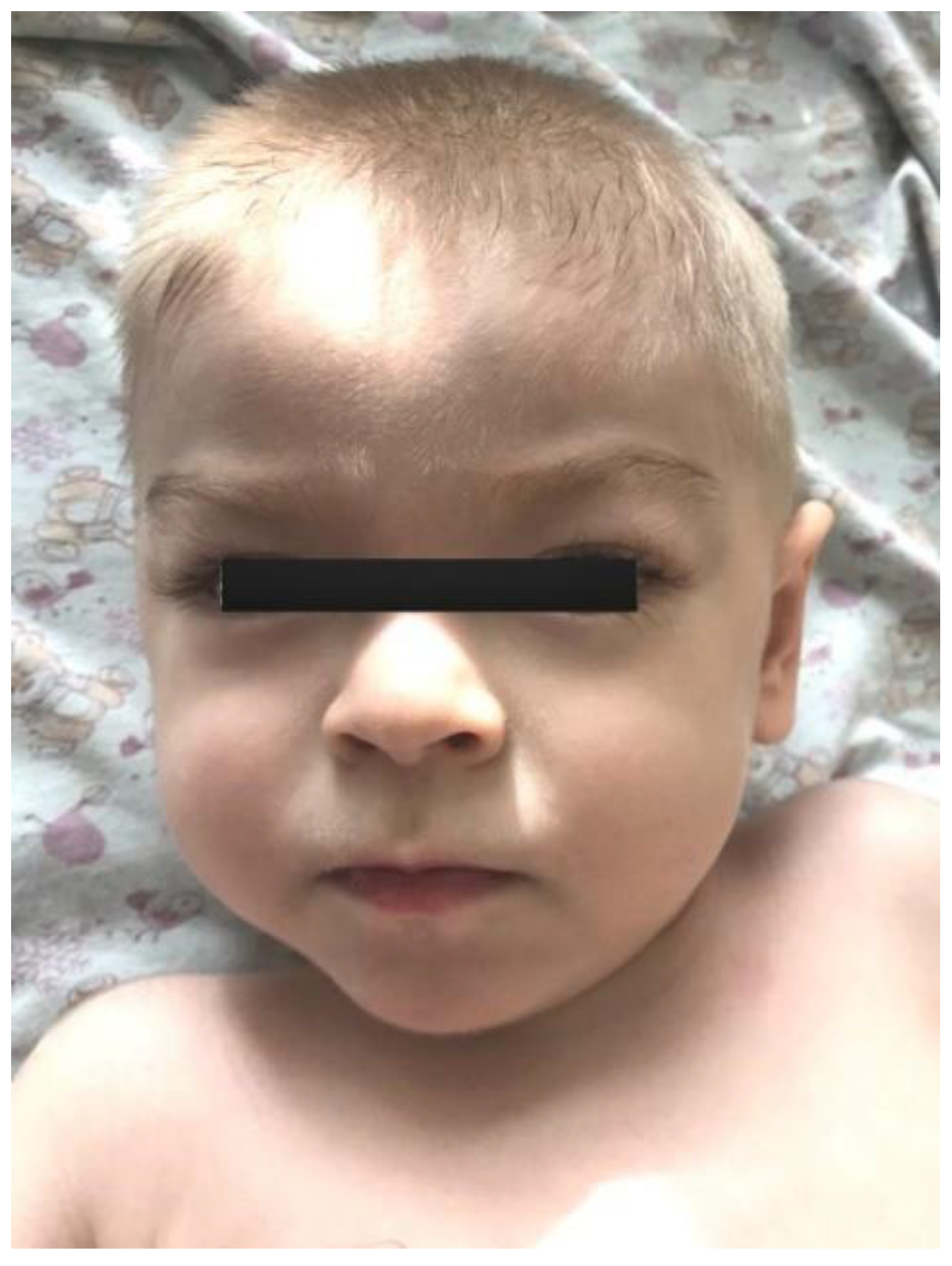
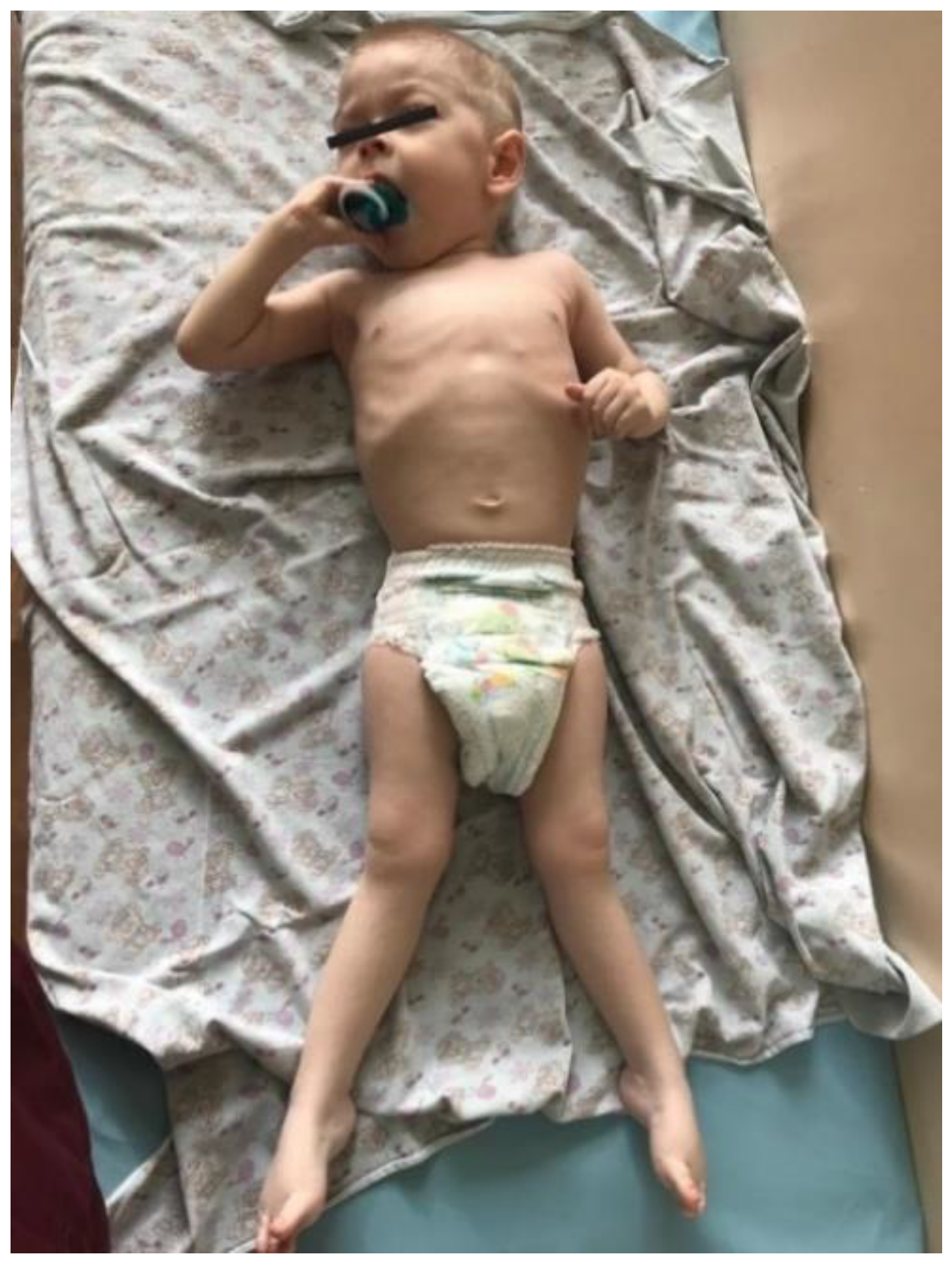
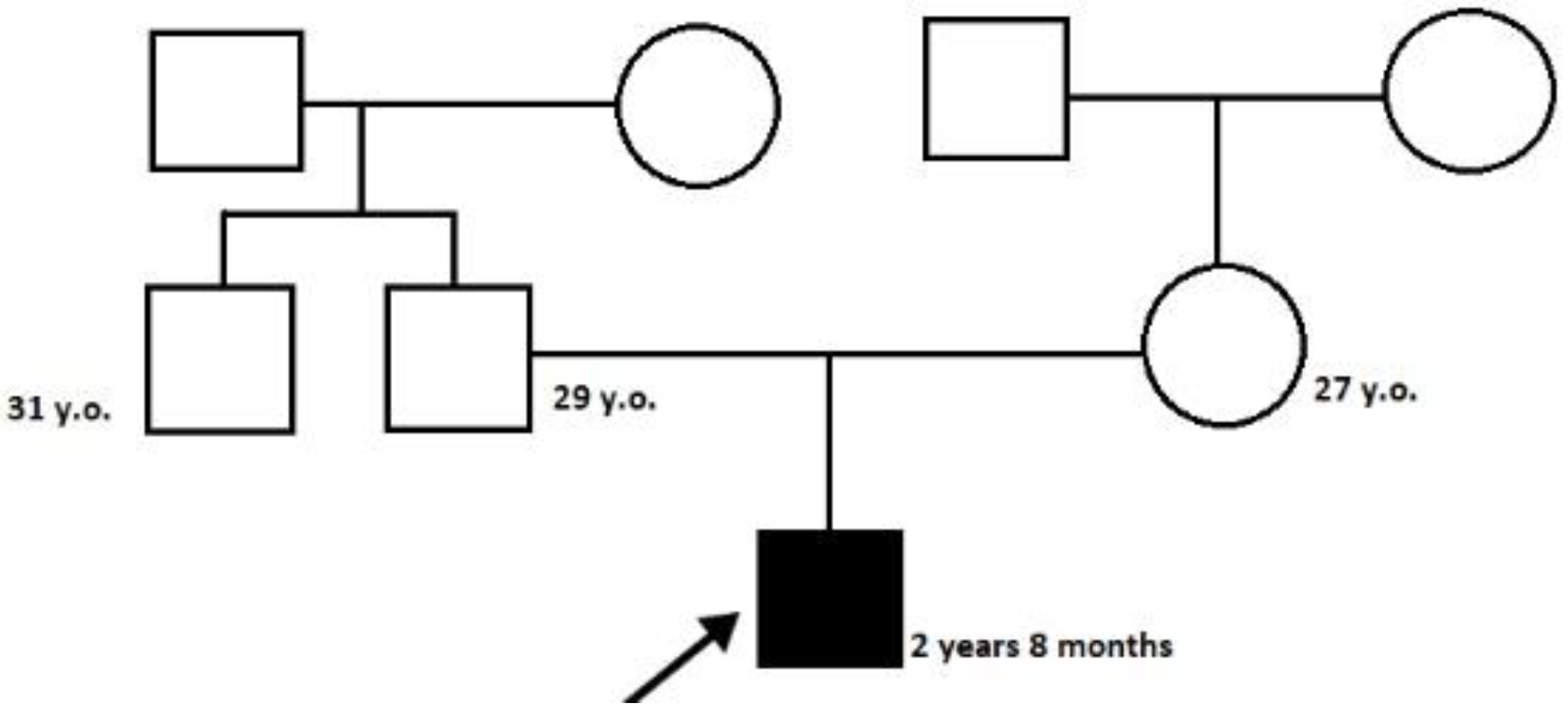
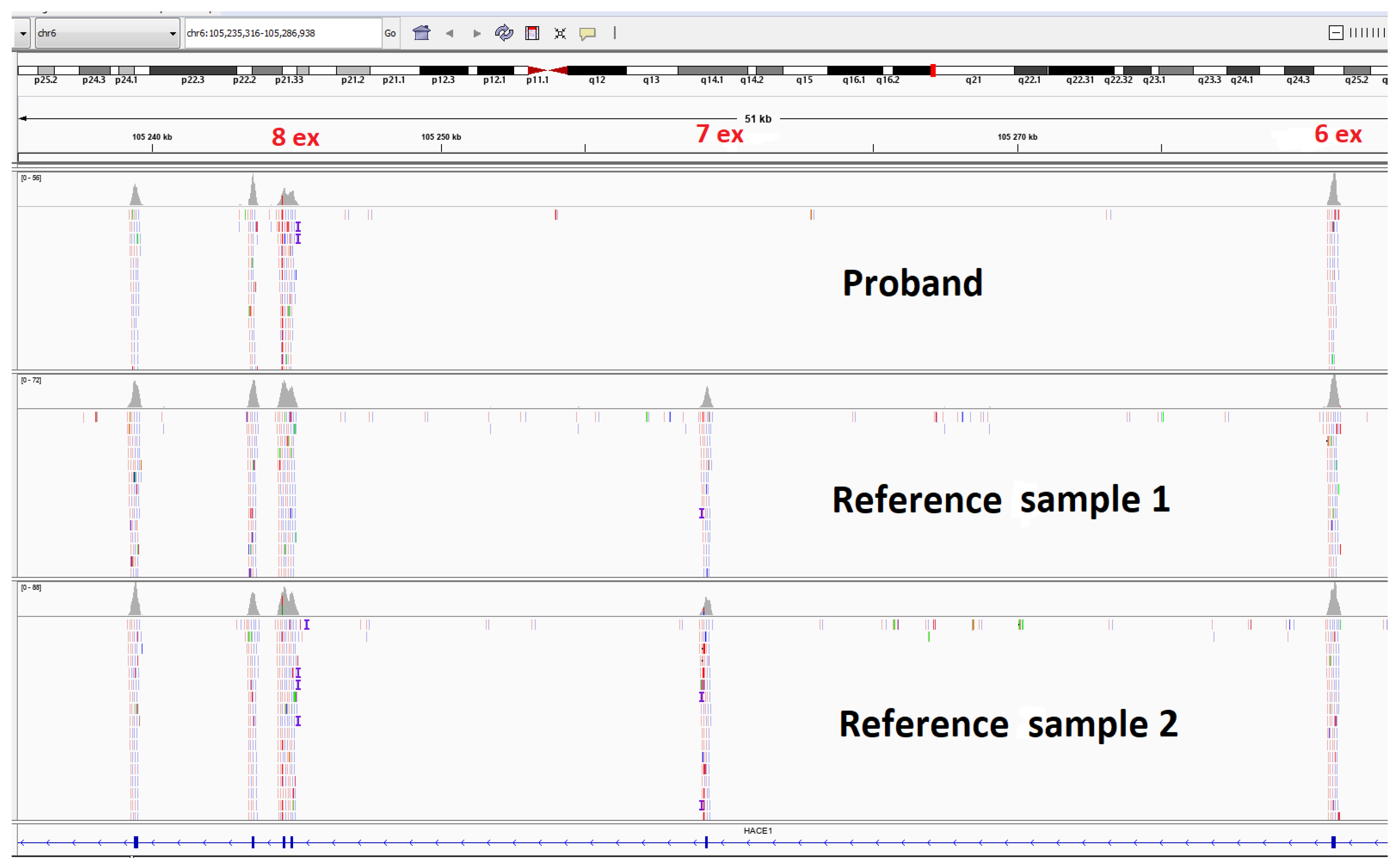

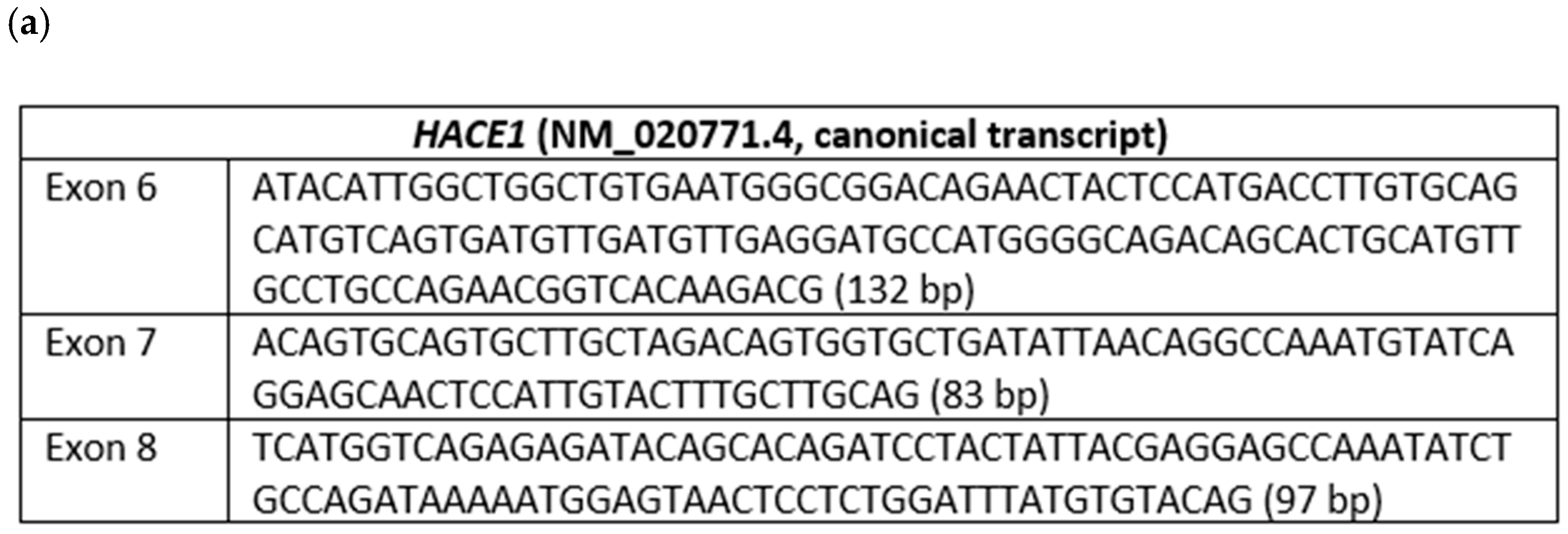

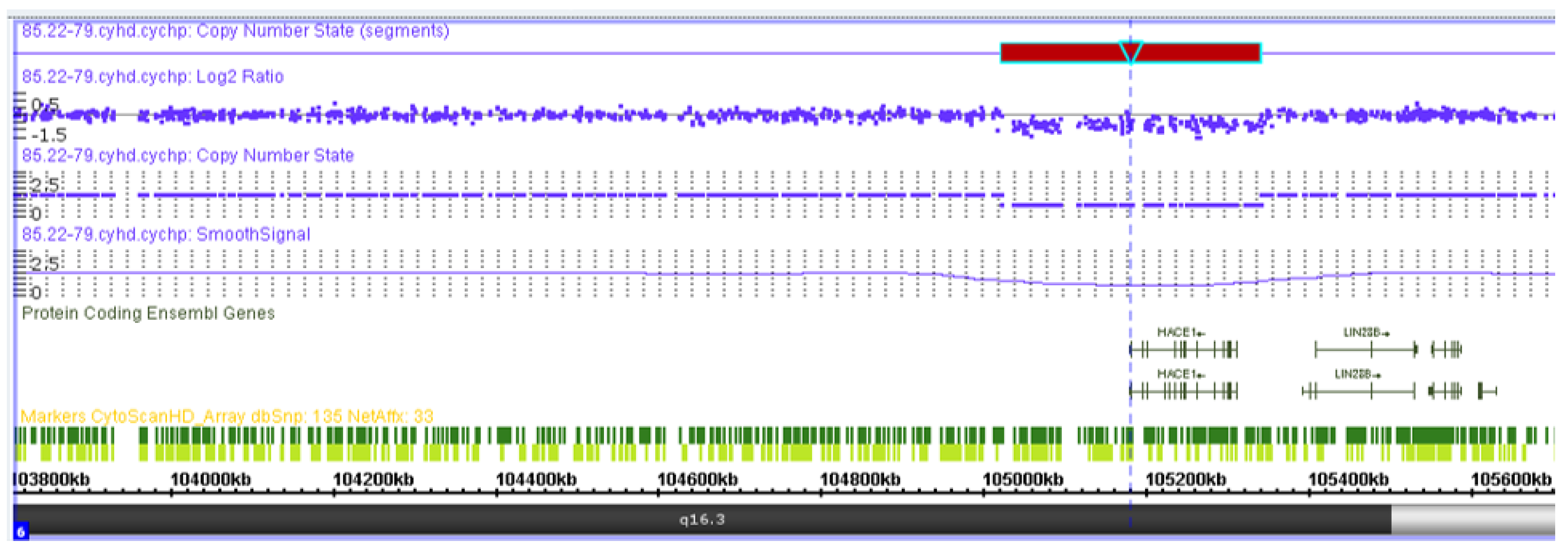

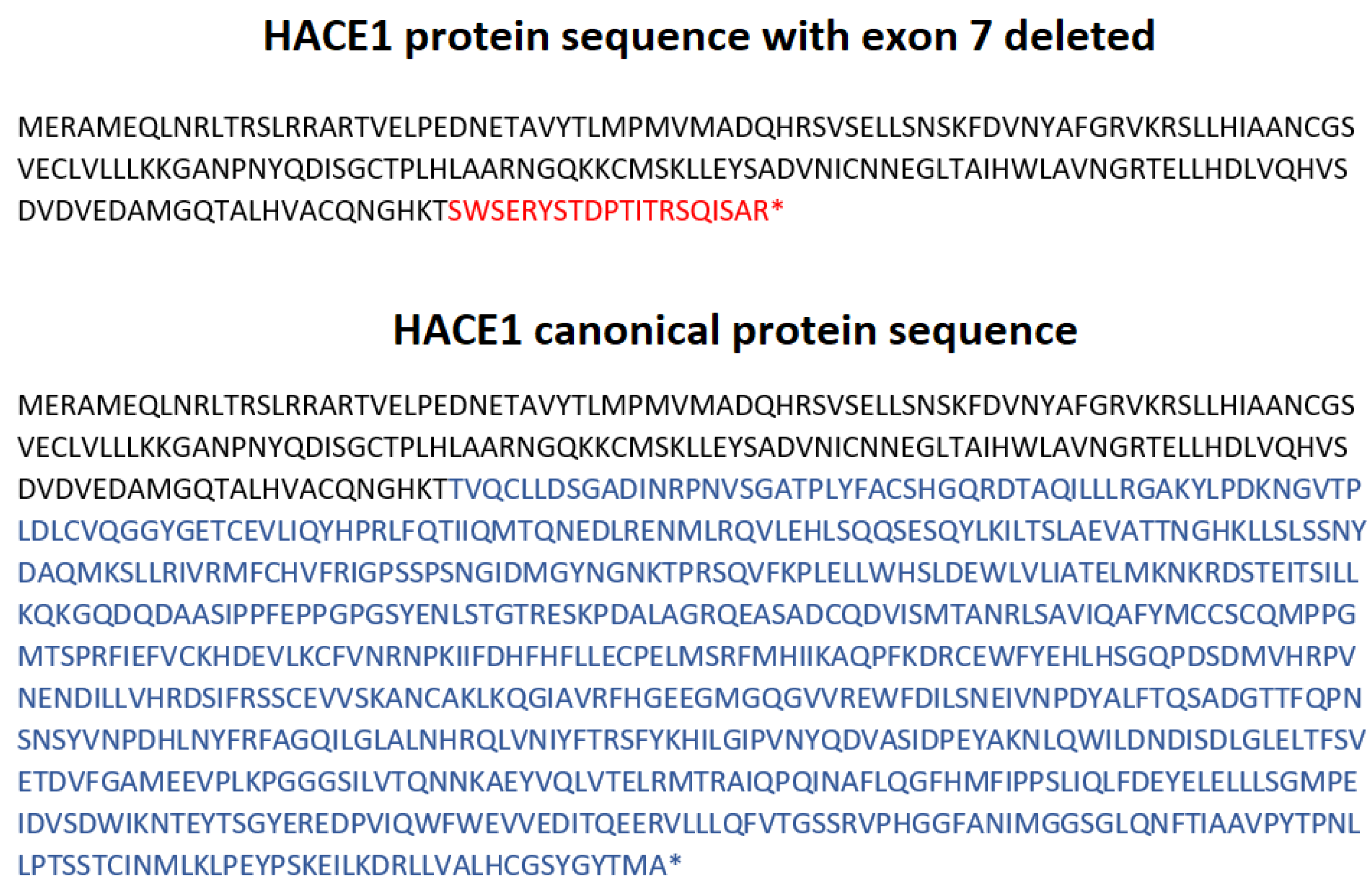
| Sex, Age, Mutation Types | Origin | Mobility | Hypotonia Reported | Developmental Delay | Spacticity (Lower Limbs) | Spacticity (Upper Limbs) | Epilepsy, Seizures | Ophthalmic Findings | Hearing | Instrumental Investigations | Other Features | Reference |
|---|---|---|---|---|---|---|---|---|---|---|---|---|
| Family (1F, 4M): p.R219*/p.R219* | Pakistan (consanguineous marriage) | Never walked (almost all affected subjects) | Yes | Yes | Bilateral spasticity | Dystonic posturing/ None | Myoclonic or tonic–clonic epilepsy (almost all affected subjects) | Divergent strabismus, myopia, retinal dystrophy | Bilateral sensorineural loss/ Normal | CT scan: generalized cerebral atrophy, ventricular dilatation EEG: consistent with myoclonic epilepsy | Hypogenitalism, kyphoscoliosis overweight | [1] |
| Family (1F, 2M): p.R748*/p.P674Ffs*5 | Germany (non-consanguineous marriage) | Unsteady, broad-based ataxic gait | Yes | Yes | Bilateral spasticity | Dystonic posturing/ None | Myoclonic seizures, focal epilepsy/None | Convergent strabismus, bilateral myopia | Normal | MRI: enlarged ventricles, hypoplastic corpus callosum | Mild talipes equinovarus, lumbar lordosis | [1] |
| Family (1M, 1F): p.R332*/p.R332* | Turkey (consanguineous marriage) | Not at 6 months | Yes | Developmental delay | Not reported | Not reported | No | Strabismus | Normal | n/a | Small feet, enlarged head circumference, inverted and widely spaced nipples, facial dysmorphic features | [12] |
| Family (1M): p.Q209*/p.Q209* | Saudi Arabia (consanguineous marriage) | Inability to sit and walk at 5 years | Yes | Severe intellectual disability, Developmental delay | Not reported | Not reported | No | Retinal dystrophy | Bilateral sensorineural loss | MRI: microcephaly, hypoplastic corpus callosum, brainstem abnormality, small sella with ectopic neurohypophysis, and mild ventriculomegaly | Mild facial dysmorphia, skeletal abnormalities, ulnar deviation of the wrists and small feet, bruxism | [12] |
| Family (1M): p.Q152*/ p.Q618Vfs*3 | n/a | n/a | Yes | Yes | Yes | n/a | Yes | n/a | Not reported | MRI: hypoplastic corpus callosum, lesions | Primary microcephaly | [14] |
| Family (1F): p.R269*/p.R269* | n/a (consanguineous marriage) | n/a | Yes | Yes | Not reported | Not reported | Yes | n/a | Not reported | MRI: hypoplastic corpus callosum, lesions | n/a | [14] |
| Family (1M): p.C80*/p.C80* | n/a (consanguineous marriage) | n/a | Yes | Yes | Not reported | Not reported | No | n/a | Not reported | MRI: hypoplastic corpus callosum, lesions | n/a | [14] |
| Family (1M): p.C80*/p.C80* | Pakistan (non-consanguineous marriage) | By 10 years was still not able to walk independently | Severe intellectual disability with greater impairment in the area of language | Paresis of the lower extremities with rigidity and exalted osteotendinous reflexes | Not reported | Not reported | n/a | n/a | MRI: diffuse cortical atrophy and an arachnoid cyst in the right temporal lobe | 3-methylglutaconic aciduria | [15] | |
| Family (2F, 1M): p.L832del/p.L832del | n/a (consanguineous marriage) | n/a | Yes | Yes | Spasticity/ dystonia | n/a | Seizures | n/a | Not reported | MRI: hypoplastic corpus callosum, cerebral atrophy | Primary microcephaly | [14] |
| Family (1M): p.W370*/p.W370* | India (consanguineous marriage) | Broad-based, crouched gait, no ataxia or fasciculations | Yes | Intellectual disability | Hypertonia, exaggerated deep tendon reflexes | Hypertonia, exaggerated deep tendon reflexes | Myoclonic seizures in limbs, no generalized seizures | Iris heterochromia, normal vision | Normal | MRI: hypoplastic corpus callosum, lesions | Hypopigmented body hair, proximal femoral focal dysplasia | [16] |
| Family (1F): p.R664*/p.R664* | n/a (consanguineous marriage) | n/a | n/a | Yes | Yes | Not reported | n/a | n/a | Not reported | n/a | n/a | [17] |
| Family (2F): c.402+5G>A/c.402+5G>A | Syria (consanguineous marriage) | Ataxic gait | Yes | Severe intellectual disability | n/a | n/a | Not reported | Not reported | Not reported | n/a | Recurrent infections | [18] |
| Family (2F + 1M): c.2212-1G>A/c.2212-1G>A | n/a (consanguineous marriage) | Motor developmental delay, regression | Yes | Intellectual disability | Dystonia | n/a | Seizures with abnormal movements | Eye movement deficit, horizontal | Not reported | n/a | Broad forehead and hypertelorism | [19] |
| Family (1M): ex 7 del/entire HACE1 deletion | Russian (non-consanguineous marriage) | Never walked | Yes | Intellectual disability with greater speech impairment | Yes (more severe than in upper limbs) | Yes | No | n/a | Normal | MRI: enlarged ventricles, cerebral atrophy | Normal urinary levels of 3-metylglutaconic acid, coarse face, mild hyperthrichosis, long eyelashes | This study |
Publisher’s Note: MDPI stays neutral with regard to jurisdictional claims in published maps and institutional affiliations. |
© 2022 by the authors. Licensee MDPI, Basel, Switzerland. This article is an open access article distributed under the terms and conditions of the Creative Commons Attribution (CC BY) license (https://creativecommons.org/licenses/by/4.0/).
Share and Cite
Kovalskaia, V.A.; Zabnenkova, V.V.; Petukhova, M.S.; Markova, Z.G.; Tabakov, V.Y.; Ryzhkova, O.P. Previously Undescribed Gross HACE1 Deletions as a Cause of Autosomal Recessive Spastic Paraplegia. Genes 2022, 13, 2186. https://doi.org/10.3390/genes13122186
Kovalskaia VA, Zabnenkova VV, Petukhova MS, Markova ZG, Tabakov VY, Ryzhkova OP. Previously Undescribed Gross HACE1 Deletions as a Cause of Autosomal Recessive Spastic Paraplegia. Genes. 2022; 13(12):2186. https://doi.org/10.3390/genes13122186
Chicago/Turabian StyleKovalskaia, Valeriia A., Victoriia V. Zabnenkova, Marina S. Petukhova, Zhanna G. Markova, Vyacheslav Yu. Tabakov, and Oxana P. Ryzhkova. 2022. "Previously Undescribed Gross HACE1 Deletions as a Cause of Autosomal Recessive Spastic Paraplegia" Genes 13, no. 12: 2186. https://doi.org/10.3390/genes13122186
APA StyleKovalskaia, V. A., Zabnenkova, V. V., Petukhova, M. S., Markova, Z. G., Tabakov, V. Y., & Ryzhkova, O. P. (2022). Previously Undescribed Gross HACE1 Deletions as a Cause of Autosomal Recessive Spastic Paraplegia. Genes, 13(12), 2186. https://doi.org/10.3390/genes13122186







